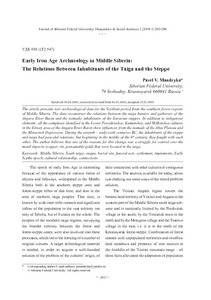Early Iron Age Archaeology in Middle Siberia: The Relations Between Inhabitants of the Taiga and the Steppe
Скачать файл:
URI (для ссылок/цитирований):
https://elib.sfu-kras.ru/handle/2311/745Автор:
Mandryka, Pavel V.
П.В.Мандрыка
Дата:
2008-06Аннотация:
The article presents new archaeological data for the Scythian period from the southern forest regions of Middle Siberia. The data reconstruct the relations between the taiga hunters and gatherers of the Angara River Basin and the nomadic inhabitants of the Eurasian steppes. In addition to indigenous elements, all the complexes identified in the Lower Porozhinskoy, Kamenskoy, and Shilkinskoy cultures in the Enisey area of the Angara River Basin show influences from the nomads of the Altai Plateau and the Minusinsk Depression. During the seventh – early sixth centuries BC, the inhabitants of the steppe and taiga had peaceful relations; but beginning in the middle of the 6th century, they fought with each other. The author believes that one of the reasons for this change was a struggle for control over the metal deposits (copper, tin, presumably gold) that were located in the taiga. Приведены новые археологические материалы скифского времени, полученные автором из южно-таежных районов средней Сибири, которые позволяют провести реконструкцию взаимоотношений таежных охотников и собирателей Приангарья с кочевниками степей Евразии. Все выделенные комплексы нижнепорожинской, каменской и шилкинской культуры, которые существовали параллельно в Енисейском Приангарье, кроме автохтонных элементов содержат признаки влияния кочевников равнинного Алтая и Минусинской котловины. Для периода VII-начала VI вв. до н.э. отмечается мирный характер взаимоотношений населения тайги и степи, а с середины VI в. до н.э. – военный. Одну из причин изменившихся контактов автор видит в борьбе за месторождения металлов (меди, олова и, возможно, золота), расположенных в ареале обитателей леса.

